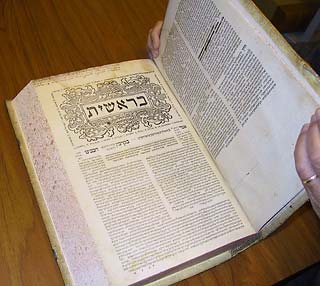UC Berkeley Press Release
Bancroft Library adds rare Second Biblia Rabbinica, Hebrew Bible
BERKELEY – The University of California, Berkeley, has obtained a rare Hebrew Bible that has served as the foundation for almost all Bibles published since its own printing in the early 1500s.
Paul Hamburg, librarian for UC Berkeley's Judaica collections, said there are likely only a dozen sets left in the world of the four-volume Second Biblia Rabbinica, including half a dozen or so in private ownership.
 The rare Second Biblia Rabbinica now in the Bancroft Library's Judaica collection, shown here open to the beginning of the book of Genesis, offers students a chance to study a key text in the history of biblical scholarship. (Bancroft Library photo) |
"These volumes are important as a text in the history of biblical scholarship and in the history of the Hebrew book as a masterpiece of Hebrew printing," said Hamburg.
"It should be especially inspiring for our students of the Bible here at UC Berkeley to be able to see these illuminating volumes with their own eyes," said Robert Alter, director of Jewish studies at UC Berkeley, a professor of Hebrew and comparative literature, and author of "The Five Books of Moses: A Translation With Commentary."
The Hebrew Bible contains the Torah: Genesis, Exodus, Leviticus, Numbers and Deuteronomy; writings of early and late prophets; and books such as Psalms, Ruth and Ecclesiastes. The first printed Hebrew Bible was published in 1488.
The First Biblia Rabbinica was published in 1517 and was edited -- with backing from the pope -- by Felix Pratensis, a Jew who had converted to Christianity. Working with old Hebrew manuscripts, he assembled biblical texts along with medieval rabbinical commentaries wrapped around the margins of the texts. It was the first to contain chapter and verse numbers in the margins.
The commentaries served as the key tool used by both Hebrews and Christians to understand biblical scripture at the time, said Ronald Hendel, UC Berkeley professor of Near Eastern studies and author of "Remembering Abraham: Culture, Memory and History in the Hebrew Bible."
Several years later, scholar Jacob ben Hayim ibn Adoniyahu of Tunis approached Daniel Bomberg, the prominent printer of Hebrew texts in Venice who had published the First Biblia Rabbinica. He convinced Bomberg that they could produce a new, more complete and accurate version.
Ben Hayim had experience in printing, a vast knowledge of the special text used for the Bible, and a deep interest in the Jewish mysticism of Kabala. He also had already edited several other religious texts for Bomberg, Hamburg said.
"People think that the Bible is what God gave to Moses," said Hendel, but in fact it is a reflection of ancient manuscripts in which leaders recorded religious information that had been passed along orally for centuries.
Bomberg relented and provided funding so ben Hayim could search out and buy manuscripts from around the world that were considered more reliable than those available to Pratensis.
When completed in 1525, the Second Hebrew Bible presented for the first time the complete Masorah, the extensive Jewish tradition concerning the correct Hebrew text of the Scriptures accumulated over centuries.
It also contained an introduction by ben Hayim to the Masoretic text. "That introduction remains a classic text in the history of biblical scholarship and the critical study of the Masorah," said Hamburg.
In addition, the Second Biblia Rabbinica has the Targum Onkelos, a classic Aramaic translation of the Bible, as well as more medieval Hebrew commentaries by rabbis than the first Rabbinic Bible.
"These would become standard aids for the study of the Bible," said Alter.
"Over the next 400 years, subsequent editions of the Hebrew Bible included more and more commentaries," Hamburg said, "but the Masoretic text and the accompanying critical apparatus compiled by Jacob ben Hayim was preserved."
The four, gold-colored volumes of the Second Hebrew Bible now at UC Berkeley are complete and in good condition and contain elaborate woodcut illustrations that surround the beginning word of each of its 24 books.
One of the intriguing aspects of this Bible is that its binding is clearly recognizable as the type done by Catholic Jesuits during the era in which it was printed. Typically, book buyers in the 16th century had books bound after purchasing them.
Another interesting discovery is that the Bible was bound in improper order, Hamburg said. For example, a poem at the end of the fourth volume is found at the end of the second volume. "At some point, it may have been lost, or it may have been that way when someone got the Bible and slipped it in and bound before anyone noticed," he said.
The Second Biblia Rabbinica was purchased with the financial support of the Geballe and Osher Family Foundations, with the help of Phyllis Cook, the executive director of the Jewish Community Federation Endowment Fund, in partnership with The Bancroft Library and UC Berkeley Collections Fund.
The Bible now housed in The Bancroft Library's rare book collection was purchased at a New York City auction. It is the only one of its kind on the West Coast. On the East Coast, the University of Pennsylvania has one, as does the Jewish Theological Seminary in New York City. In the Midwest, there's one at the University of Chicago.

